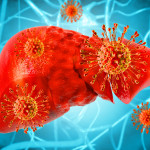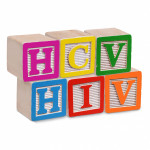 A significant proportion of HIV and hepatitis C virus (HCV)–coinfected patients receiving the experimental HCV protease inhibitor telaprevir in a clinical trial are responding quickly to treatment, according to early data from an ongoing clinical trial reported Wednesday, March 2, at the 18th Conference on Retroviruses and Opportunistic Infections in Boston.
A significant proportion of HIV and hepatitis C virus (HCV)–coinfected patients receiving the experimental HCV protease inhibitor telaprevir in a clinical trial are responding quickly to treatment, according to early data from an ongoing clinical trial reported Wednesday, March 2, at the 18th Conference on Retroviruses and Opportunistic Infections in Boston.
HCV protease inhibitors, as their name implies, attack the HCV’s protease enzyme, similar to the way in which HIV protease inhibitors work. HCV protease snips large strands of the virus into smaller pieces during the replication process, allowing them to form into new virus. There are two HCV protease inhibitors in late-stage clinical trials: Vertex Pharmaceuticals’ telaprevir and Merck’s boceprevir.
When combined with standard pegylated interferon and ribavirin, the drugs markedly improve sustained virologic response (SVR) rates (a.k.a., cure rates) in HIV-negative individuals with chronic HCV infection. While there is much enthusiasm surrounding the pending availability of the drugs, much less is known about the efficacy of these agents in patients coinfected with both HIV and HCV. Preliminary results from one coinfection trial of telaprevir were reported at CROI by Mark Sulkowski, MD, of Johns Hopkins University and his colleagues.
This study reported by Sulkowski’s group is a two-part Phase II randomized, placebo-controlled trial involving coinfected patients with genotype 1 HCV—the most common and difficult-to-treat strain of the virus in the United States—starting hepatitis C treatment for the first time. The study enrolled 60 people. This interim analysis includes 59 people who received at least one dose of telaprevir or placebo and for whom data were available.
The study’s main goal is to evaluate the safety and tolerability of telaprevir-based combination therapy in coinfected patients. A secondary goal is to evaluate rates of SVR, defined as HCV viral loads that remain undetectable six months after completing treatment.
>People in the first and second part of the study—Part A and Part B—were allotted to receive either 12 weeks of telaprevir or placebo in combination with Pegasys (pegylated interferon) plus ribavirin followed by an additional 36 weeks of Pegasys/ribavirin alone.
Part A, consisting of 13 patients, enrolled people who were not receiving antiretroviral (ARV) therapy. Part B, consisting of 47 patients, enrolled patients receiving ARV therapy—either Atripla (efavirenz/emtricitabine/tenofovir) or Norvir (ritonavir)–boosted Reyataz (atazanavir) plus Truvada (emtricitabine/tenofovir). It’s important to note that those using Atripla took a higher dose of telaprevir—1,125 milligram (mg) three-times-daily instead of the standard 750 mg dose three times a day—because of a known drug interaction between efavirenz and telaprevir.
The interim analysis, reported by Sulkowski, was conducted when all patients had reached week four of treatment. Sixty-nine percent of the patients enrolled had completed 12 weeks of therapy at the time of the analysis.
Overall, 88 percent of the study subjects were male, 69 percent were white, and the average age was 46 years old. About 68 percent had HCV genotype 1a, and most patients had HCV viral loads in excess of 800,000 copies. Ten percent of the patients enrolled had advanced liver fibrosis, as documented with liver biopsies.
After four weeks of treatment, 70 percent of people in both study parts who received telaprevir-based combination therapy had a rapid virologic response (RVR)—an undetectable viral load in less than a month, which can predict an SVR 90 percent of the time—compared with 5 percent of those who received pegylated-interferon and ribavirin alone.
As for patients in the two parts, the RVR rate was 71 percent among those who received telaprevir compared with 0 percent of patients in Part A. In Part B, among those who took Atripla, the RVR rate was 75 percent among those who received telaprevir versus 13 percent of those who received placebo. As for those who used a Reyetaz-based regimen, the RVR rate was 64 percent among those who received telaprevir versus 0 percent of those in the placebo group.
Among those who completed 12 weeks of treatment, rates of early virologic responses (EVRs)—undetectable HCV viral loads—were also reported by Sulkowski’s group. In total, EVRs were documented in 68 percent of those using telaprevir in combination with Pegasys/ribavirin compared with 14 percent of those using placebo in combination with Pegasys/ribavirin.
Two people treated with telaprevir combination therapy discontinued treatment because of side effects, compared with no patients in the placebo group. Both discontinuations occurred among those also receiving Norvir-boosted Reyataz ARV treatment.
The most common side effects thus far, occurring in at least 15 percent of study subjects, have been fatigue, rash, nausea, headache, dizziness, fevers, decreased appetite, vomiting, diarrhea and chills. Of these adverse events, rash, nausea, dizziness, fever, anorexia and vomiting occurred more frequently among those receiving telaprevir compared with placebo. Most of these side effects were mild or moderate in intensity.
“In this preliminary analysis,” Sulkowski concluded, “substantially more patients receiving a telaprevir-based regimen achieved undetectable HCV levels at week four and 12.” He added that final results from this study, exploring SVRs, are expected in 2012.





Comments
Comments